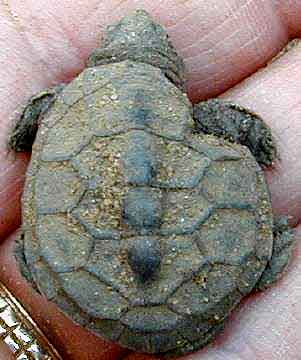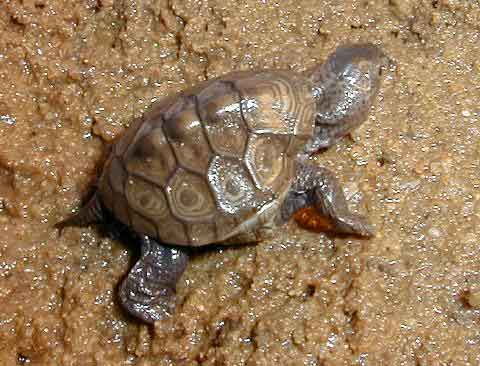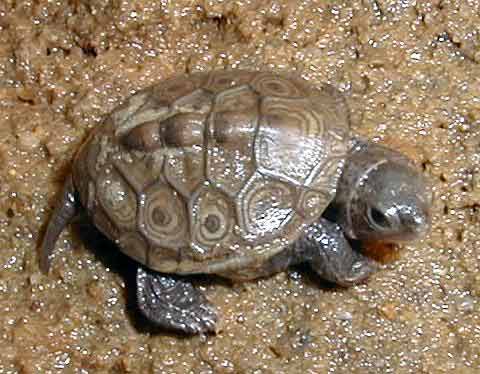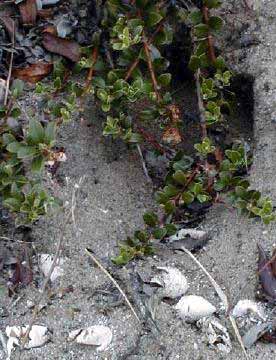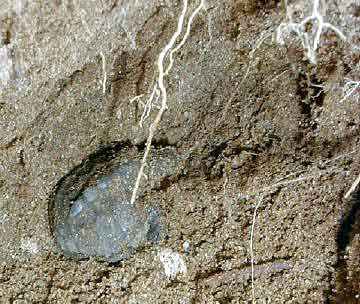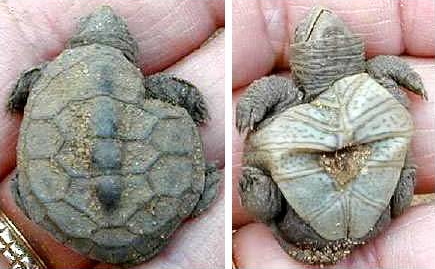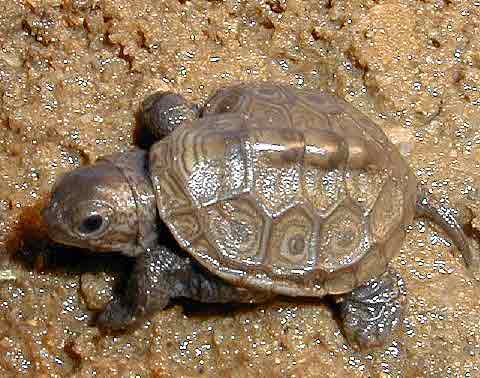Luck played its trump card today. In Blackfish Creek, clear skies and clearer visibility allowed us to net a lucky seven terrapins in this morning’s low tide, none of whom had ever been observed before. And, in the best luck of all, an unplanned visit to Turtle Point afforded us the chance to save a baby hatchling which had been dug out of its over-wintering nest by a scavenging coyote. Two thumbs up for Friday 11 May.

Steve Smith, Curator of New Bedford’s Buttonwood Park Zoo in 2001
Steve Smith, curator of the Buttonwood Park Zoo in New Bedford, Massachusetts joined me at 0730 to sample the pleasures and excitement of terrapin research in the Land of Ooze. We were blessed by sunrise temperatures in the low 60s, water temperature also in the low 60s, and a light refreshing 5 knot breeze out of the northwest.

Mature Female Terrapin Paddles through Low Tide Rip
Everything combined for a great outing with fairly good visibility as terrapins streamed through the rip. Steve netted the first turtle (#1064), a 12-year-old female of 18.55 centimeters length and weighing over 1100 grams. We traded captures for the next hour with the final tally equaling four females and three males, none of which had previously been seen.

Mature Female Terrapin with Exposed Bone from Traumatic Injury
As the tide ebbed, a terrapin pair nearly slipped by. The male, covered in light green algae, hit the scales at 240 grams; the female over a 1000 grams. She had sustained a severe injury to her left side some time ago, as it was well healed. Bone was exposed along the marginal from mid-point on the left side to the rear quadrant. The trailing edge of her left rear foot was also affected.

Tiny Over-Wintered Terrapin Hatchling in Coyote Paw Print
As we left the beach, we decided on the spur of the moment to visit the nesting areas and nursery marsh around Turtle Point — even though it’s a month shy of the season — to give Steve a sense of what the habitat looks and feels like. As we rounded the hill, I mentioned that a coyote had been frequenting this area and digging in the dunes where nests had been laid and hatched last year. I pointed to a newly excavated spot with the paw print of a coyote still clearly visible in the sand, and then my mouth dropped to the ground. Hunkered in the shade of this paw print was a terrapin hatchling! We both thought the worst, because it didn’t move and its eyes seemed shut for good. But as Steve held the baby in his palm, it began to stretch its neck and legs.

First (Over-Wintered) Hatchling of 2001 from Coyote Depredated Nest
Excavating beneath the coyote print, I discovered 5 non-viable eggs remaining in the nest chamber, 1 deformed dead hatchling which had pipped, and 6 shells from which turtles had emerged. As we left the site, we discovered another hatchling which had expired along the pathway. Both this one and the live one we recovered were extremely dehydrated and weighed less than 4 grams. The surviving turtle measured 2.7 centimeters long and 2.35 centimeters wide. She sported a desiccated yolk sac on her plastron. Had we not happened across this secluded spot and peered closely into the paw print, this hatchling would not have made it through the day.

Over-Wintered Hatchling Rescued from Coyote Depredation
Back at Connemara Cottage, I immersed Hatchling 001-01 (named Ott) in fresh water and placed her overnight in a moist, sandy terrarium. As soon as conditions allow, she’ll be released into the nursery marsh off Turtle Point.
